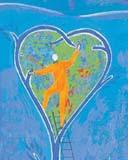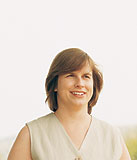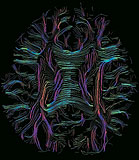Volume 20 Number 2
![]() Jump
to the Alumni section: Stanford MD
Jump
to the Alumni section: Stanford MD
X Marks the Spot
By Amy Adams
Photograph by Meredith Heuer
Illustration by Ian Worpole
Until recently, gene therapy faced a damned-if-you-do, damned-if-you-don’t dilemma. But Michele Calos has developed a technique that guides therapeutic genes to safe places on the chromosome. >> Read Story
 |
|
Heartfelt Help
By Krista Conger
Illustration by Philippe Lardy
Photographs by Meredith Heuer
Nancy Mateyka always knew she was different. Nearly 6 feet tall, she
towered over her fifth-grade classmates. But it wasn’t just her
unusual stature that convinced her there was something wrong. “I
used to joke that I looked like I swallowed a cardboard box,” she
says. “Even though I was tall and thin, I had no waistline. I’d
see other tall people, but they didn’t look like me.” The reason
would evade her for 26 years and took the life of her only sister. Mateyka
was diagnosed at age 41 with the genetic disorder Marfan syndrome. >> Read Story
 |
|
Making Public Service a Matter of Course
By Christopher Vaughan
Photographs by Leslie Williamson & Meredith Heuer
When Kristine McCoy began medical school at Stanford five years ago
she noticed something odd. Many of her classmates were not only bright
and ambitious but had a great deal of interest and experience in public
service or community medicine. >> Read Story
 |
|
Circumspect Mind Readers
By Rosanne Spector
Photograph by Roland Bammer; MRI image by Michael Moseley
Michael Moseley, PhD, an associate professor in Stanford’s radiology department, works with colleagues throughout the campus using an imaging technique to explore human cognition and psychology. He’s also working with imaging scientists and ethicists to analyze the ethical issues that arise as a result of neuroimaging findings. >> Read Story
More Stanford Medicine
- Letter from the Dean
- ’Scope: A quick look at the latest developments at Stanford University Medical Center
- Quilting Consciousness: Packard group seeks quilts for each newborn in intensive care
- Poetry
in Medicine: Two of our favorites from among this year's 38 entries
in the medical center's annual poetry contest
Letter from SMAA President
Newton J. Harband, MD
President, Stanford Medical Alumni Association
As Stanford Medical Alumni Association president I have tried to facilitate communication with the medical school by meeting with Dean Pizzo nearly every month. Living locally has made this easy for me but phone calls and e-mail make this available to all future presidents. >> Read Letter
Personal Heroes
Marcus A. Krupp, MD, who came from a small mining town in Arizona, decided at a very young age that he wanted to become a doctor; he also decided that Stanford was the place to go. The decision was just that simple and uncomplicated, says Krupp. “And I got in,” he adds. >> Read Story
Mining Data, Minding Patients
We may be living large in the Information Age but many health-care providers still rely upon Stone-Age tools when it comes to managing patient information and providing patient education. Holly Brügge Jimison, PhD, a 1990 alum in medical informatics is working to change that. >> Read Story
Brody's Paradox
William Brody, MD, PhD, suspects that health care is overdue for a switch to some form of universal coverage, but until that day comes he is improvising as fast as he can to keep Johns Hopkins hospital one step ahead of the red. “I don’t know exactly where health care is going, but if you aren’t a survivor at the end you can’t be around to participate in whatever the new order is,” Brody says. “My goal is to survive.” >> Read Story
More Stanford MD
- Spiegl honored for fund-raising service - Spiegl received his medical degree in 1948.

